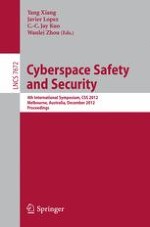2012 | Buch
Cyberspace Safety and Security
4th International Symposium, CSS 2012, Melbourne, Australia, December 12-13, 2012. Proceedings
herausgegeben von: Yang Xiang, Javier Lopez, C.-C. Jay Kuo, Wanlei Zhou
Verlag: Springer Berlin Heidelberg
Buchreihe : Lecture Notes in Computer Science
